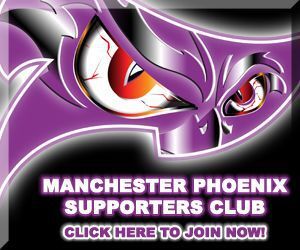- Home
- News
- Features
- Team
- Fixtures
- League Table
- Phoenix TV
- Podcast
- 200 Club
- Beginners Guide to Ice Hockey
- Supporter Sponsorship
- Phoenix Photography
- Contact
- About
Features
Pro Hockey in North America - from the majors to the minors
With the pro hockey players charity tour Hockey Stars For Hope coming to these shores next month, and the NHL lock-out cancelling out the entire 2004-2005 season, writer Robb Hitchen takes a look at the game, the players and the league structure of North America.
In the North American continent, Ice Hockey is played professionally at a number of different levels, ranging from the megabucks of the NHL, down to the ‘beer leagues’ like the SPHL. But how is this hierarchy organised? Who sits where, and why? Well, below I’m going to attempt to explain the basic structure (and also point out where some of Manchester’s former hockey players currently are plying their trade at the moment!)
Of course, the following structure is how things would normally pan out, but with no NHL action this season, the AHL has taken the role of ‘top dog’ in the North American set up. Alas, this dose not mean that AHL supporters are watching NHL standard play, as many of the top names have come to Europe, or have opted not to play at all.
So, onwards with the run down:
NHL: (National Hockey League)
These are the big boys. Thirty franchises in most of the major urban markets, split into two conferences – the Eastern and Western. These conferences are split further into three divisions each, which teams playing their divisional rivals more often than they play teams from other divisions and conferences. It’s a league for the best of the best to play in. It’s big money players playing in big money arenas. Attendances seem to be stable, but with ticket prices often exceeding $100 a game, is often too expensive for the average ‘fan in the street’. In the past, the occasional player from the NHL has played here in Britain, usually towards the end of their careers, but not always. With this season’s NHL lock-out, a trade dispute between the team owners and the players’ union, a handful of NHLers have come across to the UK to play. Steve McKenna of the NewYork Rangers has been icing this year for the Nottingham Panthers, alongside Nick Boynton of the Boston Bruins and his team-mate Ian Moran. New York Islanders’ Eric Cairns spent the season with the London Racers alongside Scott Nichol of the Chicago Blackhawks, and Toronto’s Wade Belak patrolled the blue line for Coventry Blaze. Manchester hockey fans may remember a Storm netminder by the name of Frank Pietrangelo, who plied his trade in the NHL for eight seasons on and off, and achieved the ultimate hockey glory of having his name etched on the Stanley Cup.
The NHL post season, is of course, all about the Stanley Cup. Named after Lord Stanley of Preston, the British Governor-General of Canada, the Stanley Cup was first awarded in 1893 to the Montreal Amateur Athletic Association, and has been hotly contested ever since. In the modern game, the quest for the Stanley Cup is played out in stages, from the inter-conference series, to the conference finals, and then the big one itself: The Stanley Cup finals. The current holders are the Tampa Bay Lightning who lifted the trophy at the end of the 2003-2004 season.
AHL: (American Hockey League)
The biggest of the ‘Minor Leagues’ with twenty eight franchises, often operating in the ‘secondary’ markets ( large cities not serviced by the NHL). The league features teams such as the Manchester Monarchs, and the St Johns Maple Leafs, many of whom are affiliated with NHL teams and act as ‘feeder’ teams, sending their best players up to the big league, and giving ice time to those NHLers who either aren’t quite up to the grade or are on the road to recovery following an injury.
At the end of the season, the teams enter the playoffs to see who will win the Calder Cup. The play offs are arranged thusly: eight divisional Semi Finals, (Atlantic, East, North, West), four Divisional finals, two conference finals, and the AHL final.
ECHL: (East Coast Hockey League)
The next largest ‘Minor’ league, it expanded last season to include teams from the now defunct WCHL, making the ECHL a true coast to coast league. It features twenty eight franchises operating in somewhat smaller markets (tertiary in hockey terms). Some teams you may recognise include the Greenville Grrowl, and the Bakersfield Condors. Familiar names from ECHL rosters include former Storm players Colin Pepperall, currently the captain of Greenville Grrrowl, and Dan Preston, who played twenty games for the Charlotte Checkers.
Come the end of the season, the ECHL teams who qualify play off for the Kelley Cup. The structure for these playoffs is the similar to those of the AHL: Divisional QF, Divisional SF, Divisional Finals, Conference Finals, and League Finals.
UHL: (United Hockey League)
The third of the ‘Minors’, encompassing fourteen teams in seven states, divided into three divisions. Originally it was known as the CoHL (Colonial Hockey League). Currently home to former Manchester Phoenix defenceman Mike Lankshear (Kansas City Outlaws/Richmond Riverdogs), and former Belfast Giants player Jason Ruff (Kansas City)..
The post season playoffs here are for the Colonial Cup. Because the UHL has three divisions, the top two from each division automatically qualify, whilst the next two teams are those with the best regular season records from the remaining eleven teams. These play off in a first round set of games identified as Series A/B/C/D. This then progresses to semi finals, and then a finals series.
CHL: (Central Hockey League)
The fourth ‘Minor’. Comprised of seventeen teams, divided into two conferences. Similar in size and scope to the UHL, it is currently home to former Phoenix player Eric Lind (Fort Worth Brahmas).
The playoffs here are contested for the Ray Miron Presidents Cup. The format is as follows: four conference semi finals (two per conference), two conference finals, and one Cup Finals series.
The Rest
Outside of these the sport becomes much more amateur, with the next largest organisation being the SPHL, which was formerly known as the WHA2, and is where Chad Brandimore has spent part of this current season. Another familiar name is former Nottingham player Jimmy Paek, who coached the Orlando Seals during last season.
Of course, this structure could change in the future, as plans to launch a new version of the World Hockey Association (WHA) as an alternative to the NHL are reportedly in the offing. Originally due to start in December 2004, various behind the scenes problems and a change of owners has delayed this to next season.
How do the British leagues (the EIHL and the BNL) compare to these leagues? Well, best guesses would place the EIHL at a level perhaps just above the UHL/CHL in terms of quality, with the BNL offering a standard slightly below this. Previously the ISL (in its wage cap days) was between the ECHL and AHL in standard, whilst in the wild days of unrestricted wages the ISL was probably of a similar standard to the AHL.
By Robb Hitchen
















